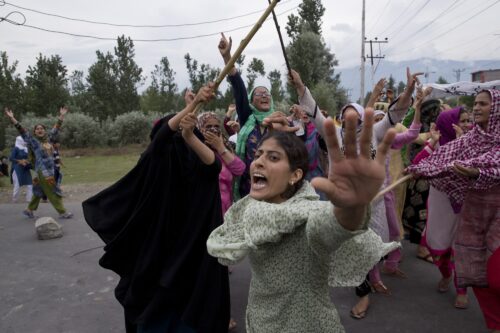By Qamar Bashir
While we in Pakistan are hurling blames and threats at each other, India has quietly tightened its grip on Indian Illegally Occupied Jammu and Kashmir (IIOJ&K) and improved its standing along the 3500 Km disputed border by silently building a bridge on the rugged Himalayas gorge. This bridge has successfully linked the Kashmir valley to
the vast Indian plains by train to achieve three strategic objectives: to further tighten its grip on IIOJ&K, to contain Pakistan, and to meet the perceived rising strategic threat from China.
The bridge named “Chenab Rail Bridge” is the highest of its kind in the world and has
been hailed as a feat of engineering that will play a pivotal role in both peace and
wartime, facilitating the movement of army personnel in larger numbers than was
previously possible. The 1,315-meter-long steel and concrete $24 million bridge connects
two mountains with an arch 359 meters above the Chenab River, completing the vital link
of the 272-kilometer railway that begins in the garrison city of Udhampur, headquarters
of the army's northern command, and runs through the region's capital Srinagar. It
terminates a kilometer higher in altitude in Baramulla, a gateway trade town near the
Line of Control with Pakistan. The railway cost an estimated $3.9 billion and has been an
immense undertaking, with construction beginning nearly three decades ago. This bridge
is the biggest civil engineering challenge faced by any railway project in India in recent
times, which would revolutionize logistics in Ladakh bordering China, achieving a huge
military advantage.
Earlier, the Indian military had to stockpile supplies, military equipment, and ammunition
transported by road in Ladakh for six months every year before the roads closed for
winter. With the construction of the bridge, the military will have a year-long sustainable
supply line. This project will also give birth to several other road tunnel projects to
connect Kashmir and Ladakh, not far from India's frontiers with China and Pakistan.The
completion of this vital bridge has given India a multitude of advantages across military,
strategic, economic, political, and security dimensions. Militarily, it enhances troop
mobility and logistical efficiency, enabling rapid deployment and sustained supply lines
in Jammu and Kashmir. Strategically, it strengthens India's position against China and
Pakistan, acting as a deterrent and reinforcing territorial control. Economically, the bridge
promotes regional development by attracting investment, boosting trade, and enhancing
tourism. Politically, it symbolizes national integration, facilitates policy implementation,
and contributes to political stability by improving living standards. Security-wise, it
bolsters disputed border monitoring and counter-insurgency operations, ensuring civilian
safety and reinforcing India's overall security posture in the region.
The Chenab Rail Bridge represents a significant strategic development with far-reaching
implications for China-India relations, India-Pakistan dynamics, the Kashmiri struggle
for freedom, and the broader South Asian region. This infrastructure project enhances
India's logistical and military capabilities in the region, particularly along the contested
borders with China. By improving troop and equipment mobility, India strengthens its
defensive and offensive positions, signaling its readiness to counter any potential threats
from China. This development not only increases India's military readiness but also
supports its broader strategy of counterbalancing China's influence in South Asia. It
would also give much-needed impetus to the strategic interests of both the USA and the
West, who are supporting India and propping it as a counterbalance power against China.
For India-Pakistan relations, the Chenab Rail Bridge exacerbates existing tensions,
particularly over the disputed region of Jammu and Kashmir. The improved infrastructure
allows India to bolster its military presence in the area, which, in Pakistan’s view, should
be a direct threat to its security and territorial claims. This increased militarization could
lead to further conflicts and heightened diplomatic tensions between the two nuclear-
armed neighbors. Moreover, the international community may pay closer attention to the
ongoing conflict in Kashmir, potentially influencing geopolitical dynamics and the
involvement of global powers.
The Kashmiri population faces both opportunities and threats from the Chenab Rail
Bridge. While improved infrastructure might bring economic benefits, there are
significant concerns about demographic changes and the erosion of Kashmiri autonomy.
Easier access to the region could lead to an influx of outsiders, potentially marginalizing
the local population and undermining their unique cultural and linguistic identity. This
development could intensify the resistance among Kashmiris, fueling their long-standing
demand for self-determination and merger with Pakistan. Additionally, the increased
militarization facilitated by the bridge might lead to more human rights violations,
drawing international condemnation and support for the Kashmiri cause.
In the broader context of South Asia, the Chenab Rail Bridge influences regional
stability, economic development, and strategic alliances. By enhancing India's strategic
posture, the project could destabilize the region by increasing military capabilities and
heightening tensions with both Pakistan and China. However, improved infrastructure in
Jammu and Kashmir could also foster economic growth through increased trade and
connectivity within India and potentially with neighboring countries. This project could
serve as a model for similar initiatives in the region, promoting economic development
and regional connectivity if managed diplomatically.
To neutralize India's advantages after completing the Chenab Rail Bridge, Pakistan
should adopt a multifaceted strategy. Militarily, Pakistan should enhance its defensive
preparedness. Economically, Pakistan must build resilience, develop infrastructure in
Azad Jammu and Kashmir. Additionally, fostering political unity within Pakistan and
ensuring good governance and human rights in Pakistan-administered Kashmir will
further strengthen Pakistan's position.
Pakistan should also intensify its international diplomacy to highlight that the
construction of the Chenab Rail Bridge in IIOJ&K is a direct violation of the UNSC
resolutions. By building such strategic infrastructure, India is unilaterally altering the
status quo of the region, thereby undermining the spirit and intent of the UNSC
resolutions, which call for maintaining the disputed nature of the territory until a fair and
impartial plebiscite is conducted under UN auspices. This not only challenges the legal
and international status of Jammu and Kashmir but also raises significant concerns about
India's commitment to resolving the issue peacefully and in accordance with international
law.




